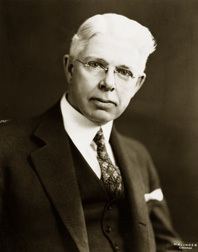 | ||
Died 18 January 1959, Chicago, Illinois, United States Books Forchheimer's Therapeusis .., Science and Technology for Development: The Role of U.S. Universities | ||
Ernest Edward Irons (February 17, 1877 – January 18, 1959) was an American physician who led several prominent medical organizations. Working as an intern under physician James B. Herrick, he identified abnormalities on a blood smear that resulted in the first published report of sickle-cell disease. He was later dean of Rush Medical College, and he was president of the American Medical Association (AMA), the American College of Physicians and the American Association for the Study and Control of Rheumatic Diseases. Late in his life, Irons spent several years as the board president for the Chicago Municipal Tuberculosis Sanitarium.
Contents
Early life
Irons was born on a farm in the area of Council Bluffs, Iowa, to Edward Irons and Mary J. Sharp Irons. In 1894, a young Irons was the founding president of the Iowa Ornithologists' Association. He remained involved with the group when he went to college at the University of Chicago. He earned a medical degree from Rush Medical College in 1903.
As a 27-year-old intern, Irons evaluated Walter Clement Noel, who had immigrated to Chicago from Grenada to enter dental school. Noel was experiencing weakness, shortness of breath and a painful sore on his ankle. After taking some blood from the patient, Irons evaluated it with a microscope and noticed the odd shape of some of the red blood cells. He alerted the attending physician, James B. Herrick, and the pair followed Noel for more than two years but ultimately lost track of him without establishing a diagnosis. After publishing reports of the man's illness in 1910, Herrick was credited with the first report of sickle-cell disease.
Career
Irons entered postgraduate study in Vienna in 1909–1910. He studied bacteriology at the University of Chicago until 1912, graduating with a Ph.D. By the mid-1910s, Irons was on the executive committee of the Chicago Society of Internal Medicine. During World War I, he was a lieutenant colonel in the U.S. Army Medical Corps and was placed in charge of the hospital at Camp Custer. At a conference of the American Hospital Association in 1919, Irons presented a paper on the elimination of waste in hospital food service operations. In introducing Irons, the conference chair cited Irons' record of reducing hospital waste. In the same year, Irons explained to The Literary Digest that Army hospitals were teaching technical skills to wounded soldiers. Irons said that even after wounds healed, a soldier remained stiff and that learning technical skills helped to rebuild his strength during the recovery process.
In the early 1920s, Irons was chairman of the Nu Sigma Nu national physician fraternity. He was dean of Rush Medical College from 1923 to 1936. He also served as president of the Institute of Medicine of Chicago. In 1934–1935, he was the founding president of the American Association for the Study and Control of Rheumatic Diseases, which was later known as the American Rheumatism Association and the American College of Rheumatology. Irons was the president of the American College of Physicians from 1944 to 1946. In 1947, Irons was part of an American Medical Association (AMA) delegation that visited Puerto Rico at the request of the United States Secretary of the Interior to report on healthcare there.
Irons was named president of the board of directors of the Chicago Municipal Tuberculosis Sanitarium (MTS) in 1948. The Chicago Tribune credited Irons with greatly improving the services, outcomes and morale at the MTS, noting that the mortality rate fell and that the center's waiting list was able to be eliminated.
He was the 1949–1950 president of the AMA. Irons and the AMA strongly opposed President Truman's proposal for a national health plan, referring to it as socialized medicine and drawing parallels to Communism. Even at his inaugural address as AMA president, Irons focused on the topic. "Nationalized medicine will be followed by nationalized industry. Industrialists see the threat to free enterprise and progress," he said. He later voiced his opposition to federal funding of both higher education and healthcare, saying, "Every subsidy carries with it the threat of regulation, despite any disclaimer of previous intent." While Irons was president, the AMA spent $1 million to fight Truman's health plan proposal.
Personal
Irons was married to the former Gertrude Thompson from Ontario. They had two children, physician Edwin N. Irons and attorney Spencer E. Irons.
Later life
In the 1950s, Irons published a book, The Story of Rush Medical College, and he started work on a history of Presbyterian-St. Luke's Hospital. In November 1958, Irons was assaulted and robbed outside of his home in Chicago. The robbers stole a dollar in change from him. Still recovering from spinal injuries sustained in the attack, Irons suffered a heart attack and died at Presbyterian Hospital in Chicago on January 18, 1959.
